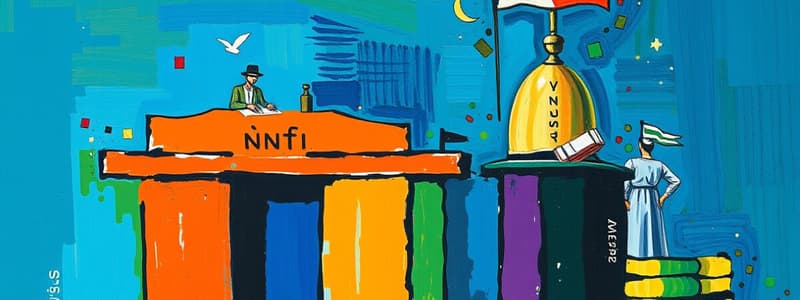Podcast
Questions and Answers
What does the Cash Reserve Ratio (CRR) represent?
What does the Cash Reserve Ratio (CRR) represent?
- The total deposits a bank can use for lending
- The portion of a bank's assets held in liquid securities
- The share of Net Demand and Time Liability that must be maintained with RBI in cash (correct)
- The interest rate banks pay for borrowing from the RBI
Which of the following tools is classified as an indirect monetary policy tool?
Which of the following tools is classified as an indirect monetary policy tool?
- Marginal Standing Facility (MSF)
- Liquidity Adjustment Facility (LAF) (correct)
- Cash Reserve Ratio (CRR)
- Statutory Liquidity Ratio (SLR)
Which of the following is a key characteristic of the Cash Reserve Ratio (CRR)?
Which of the following is a key characteristic of the Cash Reserve Ratio (CRR)?
- It has minimum and maximum limits set by RBI
- It is only applicable to public sector banks
- It applies to all scheduled commercial banks (correct)
- Banks earn interest on the cash reserved with RBI
What is the purpose of the Market Stabilisation Scheme (MSS)?
What is the purpose of the Market Stabilisation Scheme (MSS)?
Which of the following statements regarding the CRR is true?
Which of the following statements regarding the CRR is true?
What is the primary function of the Standing Deposit Facility (SDF)?
What is the primary function of the Standing Deposit Facility (SDF)?
Which monetary policy instrument does the SDF replace?
Which monetary policy instrument does the SDF replace?
When was the Standing Deposit Facility (SDF) operationalized?
When was the Standing Deposit Facility (SDF) operationalized?
What is the SDF rate in relation to the policy repo rate?
What is the SDF rate in relation to the policy repo rate?
Who is eligible to participate in the Standing Deposit Facility scheme?
Who is eligible to participate in the Standing Deposit Facility scheme?
What type of deposits can eligible entities place with the RBI under the SDF?
What type of deposits can eligible entities place with the RBI under the SDF?
Which committee recommended the Standing Deposit Facility as a liquidity management instrument?
Which committee recommended the Standing Deposit Facility as a liquidity management instrument?
What aspect of the SDF allows it to absorb significant volumes of liquidity?
What aspect of the SDF allows it to absorb significant volumes of liquidity?
What is the marginal standing facility rate primarily used for?
What is the marginal standing facility rate primarily used for?
Which of the following best defines Open Market Operations (OMO)?
Which of the following best defines Open Market Operations (OMO)?
What is the minimum borrowing amount for banks under the marginal standing facility?
What is the minimum borrowing amount for banks under the marginal standing facility?
How does the RBI conduct Open Market Operations to absorb liquidity?
How does the RBI conduct Open Market Operations to absorb liquidity?
Which statement is true regarding the Market Stabilization Scheme (MSS)?
Which statement is true regarding the Market Stabilization Scheme (MSS)?
What action does the central bank NOT take through Open Market Operations?
What action does the central bank NOT take through Open Market Operations?
What is the maximum limit of borrowing for banks under the marginal standing facility?
What is the maximum limit of borrowing for banks under the marginal standing facility?
What is one purpose of Open Market Operations for the Reserve Bank of India?
What is one purpose of Open Market Operations for the Reserve Bank of India?
In which scenario would the central bank sell government securities?
In which scenario would the central bank sell government securities?
Which of the following accurately describes the interest rate associated with the bank rate?
Which of the following accurately describes the interest rate associated with the bank rate?
What kind of securities does the Central Government issue in India?
What kind of securities does the Central Government issue in India?
What is the maturity period for treasury bills?
What is the maturity period for treasury bills?
How are Government Securities (G-Secs) issued in India?
How are Government Securities (G-Secs) issued in India?
What does G-Secs primarily signify in terms of risk?
What does G-Secs primarily signify in terms of risk?
What is the purpose of the E-Kuber platform?
What is the purpose of the E-Kuber platform?
Which Government entity issues State Development Loans (SDLs)?
Which Government entity issues State Development Loans (SDLs)?
What does the Public Debt Office (PDO) of RBI manage?
What does the Public Debt Office (PDO) of RBI manage?
What type of markets can G-Secs operate in due to their low risk?
What type of markets can G-Secs operate in due to their low risk?
What mechanism encourages banks to extend export credit?
What mechanism encourages banks to extend export credit?
What are the typical maturities for Government bonds or dated securities?
What are the typical maturities for Government bonds or dated securities?
Which of the following is not a member of the Monetary Policy Committee (MPC)?
Which of the following is not a member of the Monetary Policy Committee (MPC)?
What is the required minimum number of meetings for the MPC in a year?
What is the required minimum number of meetings for the MPC in a year?
What is the tenure for members of the MPC appointed by the Central Government?
What is the tenure for members of the MPC appointed by the Central Government?
Who has the casting vote in the event of a tie during voting in MPC meetings?
Who has the casting vote in the event of a tie during voting in MPC meetings?
Which role does not belong to the members of the MPC?
Which role does not belong to the members of the MPC?
What is the primary function of the MPC related to monetary policy?
What is the primary function of the MPC related to monetary policy?
How many members in the MPC are appointed by the Central Government?
How many members in the MPC are appointed by the Central Government?
What is the quorum required for an MPC meeting?
What is the quorum required for an MPC meeting?
Study Notes
Monetary Policy Overview
- Monetary policy is controlled by the Reserve Bank of India (RBI) to regulate the economy and ensure stability.
Key Monetary Policy Tools
-
Direct Tools include:
- CRR (Cash Reserve Ratio): A requirement for banks to hold a percentage of NDTL as cash with RBI with no interest paid.
- SLR (Statutory Liquidity Ratio): Required ratio of liquid assets banks must maintain.
-
Indirect Tools include:
- LAF (Liquidity Adjustment Facility): Adjusts liquidity through borrowing against securities.
- Bank Rate: The rate at which RBI lends to commercial banks.
- MSF (Marginal Standing Facility): Allows banks to borrow overnight at a higher rate.
- OMO (Open Market Operations): Sale/purchase of G-Secs by RBI to regulate money supply.
- MSS (Market Stabilization Scheme): Introduced in 2004 to manage liquidity in the economy.
Cash Reserve Ratio (CRR)
- No minimum or maximum limits; applicable to scheduled commercial banks.
- Stated in the RBI Act 1934, Section 42(1).
- Banks must maintain CRR in cash with RBI, impacting their lending capacity.
Government Securities (G-Secs)
- Issued through RBI auctions on the E-Kuber platform.
- G-Secs are low-risk investments, classified as treasury bills (less than one year) or bonds (one year or more).
- Public Debt Office manages the issuance and transactions of G-Secs.
Refinance Facility
- Export credit refinance facility provided under Section 17 (3A) of the RBI Act 1934, facilitating banks in extending export credits.
Marginal Standing Facility (MSF)
- Rate at which commercial banks can borrow overnight from RBI.
- Minimum is 1 crore; Maximum is 2% of NDTL.
Open Market Operations (OMO)
- Conducted by RBI through the sale/purchase of G-Secs; aims to control liquidity and stabilize the economy.
Market Stabilization Scheme (MSS)
- Designed for liquidity management; enables RBI to buy/sell government securities to stabilize the economy.
Standing Deposit Facility (SDF)
- Launched in 2022 to enhance liquidity management without collateral.
- Acts as a floor for the LAF corridor, replacing the previous fixed-rate reverse repo.
Monetary Policy Committee (MPC)
- Comprised of six members: three from RBI and three appointed by the Central Government.
- Members serve a four-year term and are tasked with setting the policy repo rate to control inflation.
- Required to meet at least four times a year, with a quorum of four members.
- Majority decisions, with the Governor holding a casting vote in the event of a tie.
Current Members of the MPC
- Governor of the Reserve Bank of India (Chairperson)
- Deputy Governor of RBI in charge of Monetary Policy
- Nominated officer from RBI Central Board
- Ashima Goyal, Jayanth R. Varma, and Shashanka Bhide as academic and advisory members.
Studying That Suits You
Use AI to generate personalized quizzes and flashcards to suit your learning preferences.
Description
This quiz delves into the Standing Deposit Facility (SDF) as a liquidity management tool, including its origins from the Expert Committee's recommendations in 2014 and its significance under the RBI Act. Test your understanding of the SDF and its role in monetary policy.




